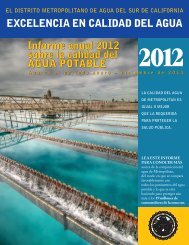Orange County Basin - Metropolitan Water District of Southern ...
Orange County Basin - Metropolitan Water District of Southern ...
Orange County Basin - Metropolitan Water District of Southern ...
You also want an ePaper? Increase the reach of your titles
YUMPU automatically turns print PDFs into web optimized ePapers that Google loves.
Chapter IV – Groundwater <strong>Basin</strong> Reports<br />
<strong>Orange</strong> <strong>County</strong> <strong>Basin</strong>s<br />
Groundwater Contaminants<br />
Key constituents <strong>of</strong> concern for the <strong>Orange</strong> <strong>County</strong> <strong>Basin</strong> include: total dissolved solids, nitrate,<br />
volatile organic compounds (VOCs), perchlorate, colored water, and NDMA. The nitrate and<br />
VOC contaminants are located in the shallow aquifers and none <strong>of</strong> these contaminants have<br />
significantly impacted the groundwater basin’s operation. In many portions <strong>of</strong> the groundwater<br />
basin, shallow water is prevented from migrating into deeper aquifers due to aquitards<br />
(impervious formations). Additionally, OCWD has aggressively initiated programs to address<br />
contaminants <strong>of</strong> concern before they become larger issues. A summary <strong>of</strong> these constituents is<br />
provided in Table 10-6.<br />
TDS concentrations range from 221 mg/L in Seal Beach area to more than 1,000 mg/L in<br />
portions <strong>of</strong> the Irvine subbasin (OCWD, 2006). Increasing concentrations in forebay areas <strong>of</strong> the<br />
Main basin are shown in Figure 10-11, which have led to management approaches such as using<br />
low TDS groundwater replenishments and desalters. Areas <strong>of</strong> high TDS (>1,000 mg/L) in the<br />
Irvine subbasin areas are shown in Figure 10-12.<br />
Nitrate concentrations generally range from 4 to 7 mg/L in Forebay and 1 to 4 mg/L in the<br />
Pressure area with an average <strong>of</strong> about 2.2 mg/L (OCWD, 2004; OCWD, 2006). Areas with<br />
concentrations above 10 mg/L are located in inland areas. Nitrate concentrations that exceed the<br />
MCL occur only in a small number <strong>of</strong> areas in the <strong>Orange</strong> <strong>County</strong> <strong>Basin</strong> (OCWD, 2004). Nitrate<br />
plumes that are generally located in the shallow aquifers in the basin are shown in Figure 10-12.<br />
Localized shallow aquifer areas, as shown in Figure 10-12, are also affected by high<br />
concentrations <strong>of</strong> volatile organic compounds (VOCs), most notably trichloroethylene (TCE) and<br />
tetrachloroethylene (PCE). OCWD has active remediation projects to remove these VOC and<br />
nitrate contaminants before they reach the Principal aquifer system.<br />
Perchlorate has primarily been detected in the Forebay area and in only one well in the<br />
<strong>Orange</strong> <strong>County</strong> <strong>Basin</strong> at concentrations at or below the current State notification level <strong>of</strong> 6 µg/L.<br />
As discussed above, the presence <strong>of</strong> colored water is significant in the <strong>Orange</strong> <strong>County</strong> <strong>Basin</strong>.<br />
However, colored groundwater is limited to the Lower aquifer system primarily near the coast<br />
and ranges from 25 color units to 230 color units. The area <strong>of</strong> colored groundwater is shown in<br />
Figure 10-13. Most production wells along the coast pump from the Principal aquifer, which is<br />
above the colored water.<br />
Blending Needs<br />
The local retail producers serve a blend <strong>of</strong> groundwater and MWD imported water supplies. The<br />
blend percentage primarily depends upon the BPP. The average TDS <strong>of</strong> blended water in agency<br />
systems ranges from 315 mg/L to 560 mg/L with an average <strong>of</strong> 450 mg/L. Nitrate<br />
concentrations <strong>of</strong> blended water range from 0.1 to 3.5 mg/L with an average <strong>of</strong> 1.4 mg/L<br />
(OCWD, 2006).<br />
FINAL IV-10-18 September 2007




